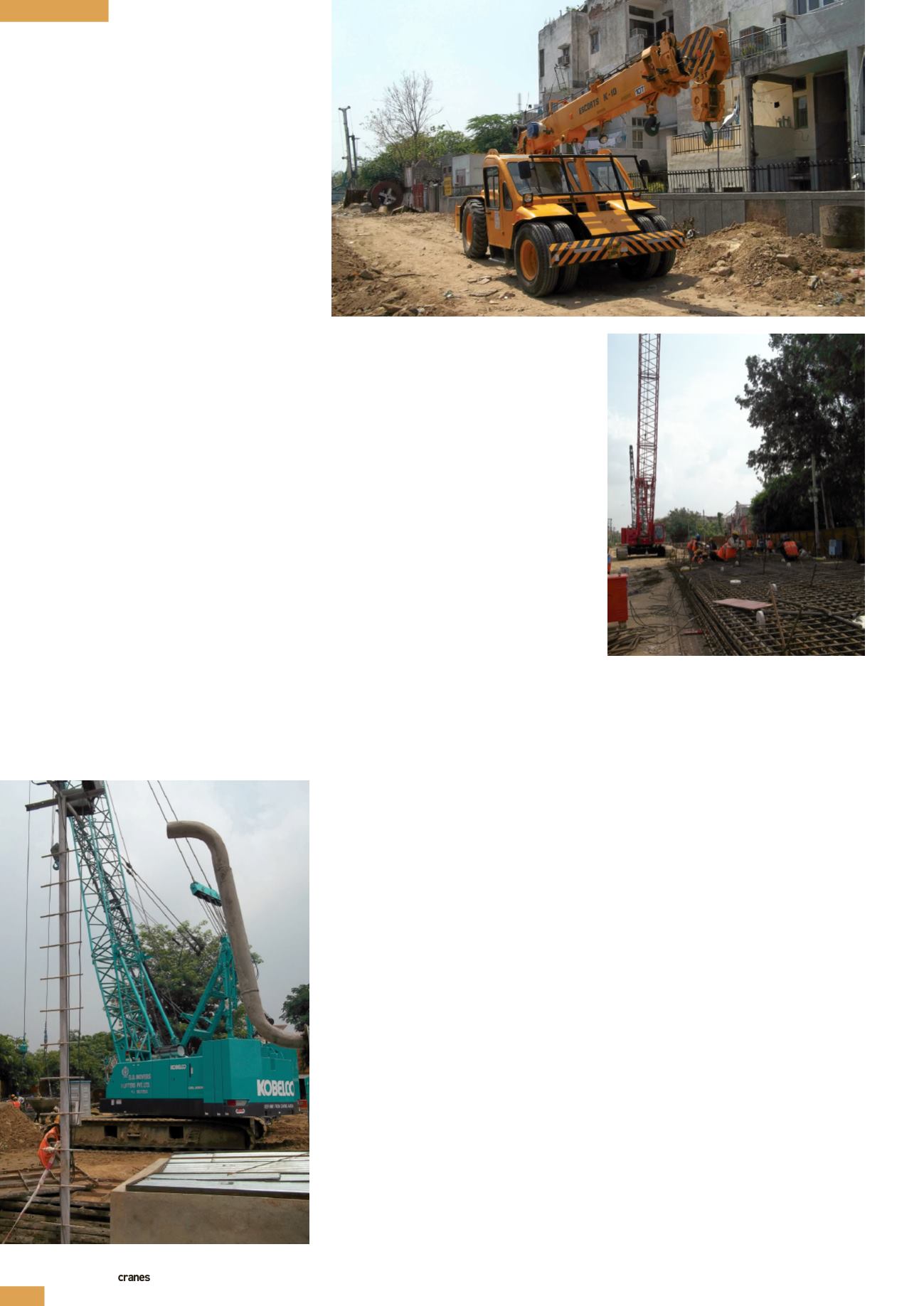
INDIA
INTERNATIONAL AND SPECIALIZED TRANSPORT
■
OCTOBER 2013
50
(HCC-Samsung), explains, “One of the
biggest challenges is the given limited shaft
area for lowering and retrieving sections
of tunnel boring machines as the project is
taking place in heavily congested city areas.”
HCC-Samsung is working on CC-34
package, one of the vital pockets of third
phase. The project comprises construction
of a 250 metre station that will connect the
densely populated Dhasrath Puri area in
West Delhi with the domestic airport. The
station is being constructed at a depth of
26 m from the surface with a width of 28 m.
On site a Manitowoc MLC 100
hydraulic crawler crane supported by a 75
tonneTelcon Tata (TFC 280) friction duty
cycle crawler crane is being used to lower
a 20 tonne diaphragm wall cage. The MLC
100 is working with a 34 m boom. It is
also helping prepare the diaphragm walls
by lowering and then removing stop end
frames at both sides of the diaphragm wall
cage. Other work for the 100 tonne
MLC 100 includes holding the hopper
attached with termi pipe along with
the TFC 280 for pouring concrete. TFC
280s are being used for the third phase,
particularly for concrete pouring and
unloading 20 – 23 tonne precast concrete
girders from trailers for the superstructure.
Gautam says, “Although the hydraulic
crane is not working to its optimum
capacity we opted for the crane because
with its longer boom it will be able to
lower and retrieve sections of TBM and
other heavier materials at deeper depths,
bypassing the restrictions posed by
limited shaft area, during the later part
of the project. Furthermore, it is safe and
has higher uptime as is required in our
compressed work schedules.” The majority
of the cranes working at the third phase of
the project have been hired by contractors
from crane rental companies.
Latest generation
DMRC has strictly stipulated in its tender
documents prohibiting the use of old
generation cranes in the third phase which
were used in the first and second phase.
Dayal explains why, “We have decided
to introduce new age cranes to further
enhance safety and performance. The new
cranes should have in built safety features
and better stability for undulation which
may be encountered at the construction
sites.” DMRC has engaged independent
agency for certifying the cranes to be used
at its site.
Also working on site is a Kobelco
CKL 1000-I. The lattice boom crawler
crane was manufactured in India and is
working at CC-27 station, which is being
constructed by L&T-Shanghai Urban
Construction Group JV. Aided by a longer
boom, the new 100 tonne capacity crane is
being used to lower diaphragm wall cages
at CC-34 project, which is supported by a
TFC 280 crane. Dipankar Ghosh, plant and
machinery manager at L&T-SUCG says,
“We have reconfigured the boom from
30 to 35 metres to provide a better reach
required at our job site, which has restricted
space. With a longer boom the crane can
easily lift the longer diaphragm wall cage
for lowering. The crane will be much more
suitable with its longer boom to lift and
lower universal and vertical beams that will
be required for cut and cover construction
methods at our site in the future.”
At the L&T-SUCG CC27 project, a 500
>
Construction equipment company Escorts
supplied 90 % of the new variants of the TRX
series mobile slewing cranes
A Kobelco CKL 1000-I lattice crawler crane
being used to lower diaphragm wall cages
commercial and residential areas. A record
number of 25 tunnel boring machines
are going to work simultaneously on the
project. At four points the tunnels are going
to pass below the operational tunnels of
Delhi Metro. At one section the metro will
pass over the existing viaduct of Airport
Express metro Link that presently connects
the city centre with Delhi’s new modernised
international airport.
Anuj Dayal, senior official spokesman,
DMRC, said, “Taking into account the
complexities in way of project execution,
we are employing the latest and safest
construction technologies available. For
underground corridors, we are primarily
using tunnel boring machines. We have
opted for underground corridors wherever
the alignment passes through congested
areas as our intention is to cause minimum
possible inconveniences to the people
during construction work. For the third
phase, we are using an advanced box
pushing technique as it will help us to carry
out construction without carrying out large
excavation or digging.”
Lifting challenges
Despite the advanced construction
techniques being adopted, challenges are
galore for crane operators working on the
project. Vivek Gautam, senior site engineer
of joint venture company Hindustan
Construction Corporation- Samsung
A Manitowoc MLC 100 lattice
boom crawler at work on site


